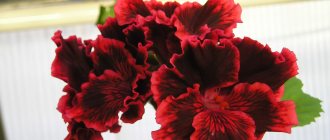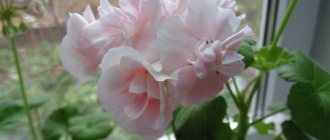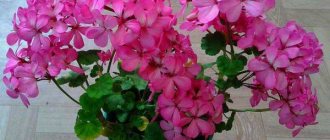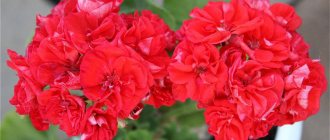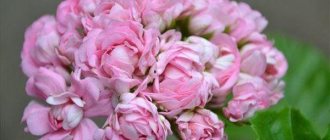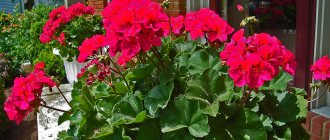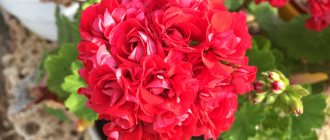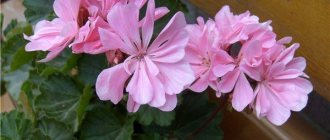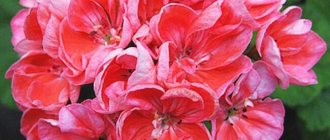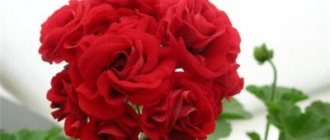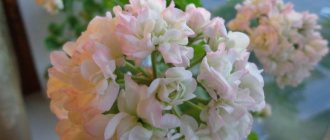Popular varieties
The description of terry pelargonium will be incomplete if we study the key features of the category as a whole. In order for you to be able to clearly decide which varieties you want to root in your own garden plot, be sure to consider their main advantages and characteristics. Only in this case will you select for your flowerbed or garden design those varieties of geraniums that will look harmonious.
Edwards Christina
This pretty compact shrub is covered with flowers that form a dense cap. The buds have a soft pink tint, close to peach, and they are quite voluminous. Providing proper care for the plant at home will not be difficult for you, and flowering Edwards Christina will bring you a lot of pleasure.
Martha
A variety of domestic pelargonium called Martha is a compact domestic shrub. It is covered with white voluminous flowers with slight terry around the edges. The leaves of this plant have a soft green tint. In order for this flower specimen to develop fully, it is very important to place the pot with the sprout in a shaded place. The thing is that such geraniums do not tolerate direct sunlight very well.
South African sun
The South African sun variety of pelargonium is a dwarf variety of this plant. Such a specimen will certainly not go unnoticed on your windowsill. Double flowers of a bright red hue form on the stem. Despite the fact that this variety itself is compact, its branching is not bad, so it will make a lush flowering decoration for your home. The leaves of this geranium have a rich light green tint.
Among the main advantages of this variety, it is worth highlighting first of all the fact that even a novice gardener can form a shrub.
Gardenia
What is good about the Gardenia geranium variety is its aesthetic appearance and versatility. It can be safely grown not only at home, but also in open ground. This variety will become a true decoration for a park area or garden; with its help you can decorate the landscape of your own dacha area.
An elegant plant with white buds blooms for a long time. In this case, one pinching will be enough to form an indoor miniature shrub correctly and soon enjoy the blooming flowers.
Bold rose
The Bold rose pelargonium variety is notable for its bright buds. They are full-color, terry, and also form a dense cap. Caring for such a plant is not difficult; all you need to do is follow the basic recommendations for growing geraniums.
Lara enwoy
The pelargonium variety called Lara enwoy primarily stands out among the entire diversity of the group for its large double flowers. They are painted in salmon color, which harmoniously combines with white. The shrub grows compact, but its stems are quite strong.
This variety of indoor pelargonium is one of the achievements of Australian breeders. Such a floral specimen will look unusual in any gardener’s collection. That is why if you want to have a rare and unusually beautiful variety of geranium, you should give preference to this particular variety.
Description of popular varieties of pelargonium from the Toscana series
Pelargonium PAC Viva Madeleine, Carolina and other varieties
Thanks to the work of breeders, the color palette is wide, from soft marshmallow (Regina variety) to rich scarlet with dark spots (Dark Red variety). Varieties differ in color, shape, size and type of inflorescences.
Toscana Bernd
Pelargonium Toscana Bernd is a double and zonal beauty. Rare deep red color of inflorescences collected in bright bunches. Pelargonium Tuscany Bernd blooms profusely, covering the entire top with red balls.
Toscana Edwards
Pelargonium with red-orange inflorescences is distinguished by a white lining on the back of the petals and at their base. Pelargonium Edwards Tuscany blooms earlier than its sisters and blooms for a long time.
Edwards Tuscany
Toscana Renske
The red-burgundy small inflorescences of this variety densely cover the surface of the compact bush. The plant can be used as a hanging or potted plant. Blooms early and blooms for a long time.
Toscana Castello
Varieties of this variety come in many shades of red and pink. The inflorescences are dense and resistant to fading. The bush is medium, erect, suitable for planting in flower beds.
Toscana Hero
A beautiful combination of dark red-pink spots on the petals, with a white tint. The hiro bush is dwarf, and the inflorescences themselves are very large. The velvet shade shimmers in the sun. Blooms profusely, almost continuously. Medium size with the same flower color - Tammo geranium.
Variety Hero
Growing rules
Even the most popular varieties of home geranium (Country, Desert, Gogodansaren, Warrenorth, Vastanbyn, Madame bowary) are not considered whimsical. However, key tips for caring for them are worth remembering if you want to encourage long-term flowering in your specimen.
First of all, the temperature in the room where your home flower is located should not fall below +10 °C. Place the potted plant in a west or east window as the lighting there is never too bright. If your flower specimen always stays on the south window, it is advisable to shade it on hot summer days.
Be sure to take care to saturate the plants with complex fertilizers from time to time. Watering should be moderate, and the presence of drainage holes in the flowerpot is mandatory.
Whatever varieties of geranium you prefer to root in your home (Black, Blue, Jacqui caws, Jagershus, Orange, Pleasure, Rubbelitte, Dessert, Madame, Orange, Powder Pouf, etc.), caring for them will not be difficult even for a beginner . But the result will certainly impress both you and your guests.
myorchidea.ru
Growing problems, diseases and pests
When growing the plant there is a risk of leaves turning yellow and falling off. Such problems are most often caused by insufficient lighting.
If you overwater, watery blisters appear on the leaves. This means that the plant does not have time to evaporate moisture.
In the fresh air, geranium can become infected with fungal infections.
How to deal with them
To prevent fungal infection, bushes should be treated with complex fungicides. To cope with harmful insects, it is recommended to use insecticidal preparations.
As diseases develop, brown spots appear on the leaves.
Pelargonium Millfield Rose is a wonderful ornamental crop that serves as a real decoration for the room. In order for the plant to bloom profusely and luxuriantly, it requires high-quality care.
Description and characteristics of cultivation
Interestingly, among all the variety of varieties, it is dwarf geranium that is becoming increasingly popular. It has many advantages. For example, such a plant will take its rightful place on the windowsill and fit perfectly into any of your flower collections.
It is grown in a compact pot, since the flower is very miniature. Nevertheless, its small dimensions do not prevent it from blooming magnificently. Another important advantage of this group of geraniums is that formative pruning of such a flower specimen is not necessary at all.
Caring for dwarf pelargonium varieties at home is not too labor-intensive; even a beginner can handle it. However, take some recommendations into account so as not to harm your indoor flowers. For example, like most geraniums, dwarf pelargonium does not like waterlogged soil - it will cause the rhizome to rot before you even blink an eye. That's why remember two things:
- The plant substrate should be moistened in moderation;
- The soil must contain sand or vermiculite. Such components are useful because they absorb excess moisture, and you do not have to correct the consequences of waterlogging the soil.
You will certainly be able to care for low-growing varieties of pelargonium. Over time, many gardeners begin to expand their collection of dwarf geraniums. This can be done easily and at home, no extra costs will be required.
How are these flowers propagated? It is best to start this procedure at the end of February or early March. It is during this period that the plant gradually comes to its senses after wintering, and its vital processes are activated. First of all, cut the cutting with two internodes, and then dry it thoroughly.
The next stage is planting in nutrient soil. It is not recommended to cover the top of the cutting with glass or film - this will only create an excessively humid environment for the geranium, which can have a detrimental effect on it. Miniature cuttings of pelargonium will very quickly take root in a new place. The main thing is to place the pot with the shoots in a well-lit place. Under favorable conditions, within a month you will receive a fully rooted plant.
Of course, you can’t do without transplanting homemade miniature geraniums. This procedure is not performed very often. If you notice that the flower has grown sufficiently, and, most likely, there is no longer enough space for the rhizome in the mini-pot, you can place it in a slightly larger pot. But don’t overdo it: if you plant a plant in a flowerpot that is too large, it may simply die, because the root system will not fill the bottom of the container, and without this the flower will not begin to develop.
In order for pelargonium varieties Dovepoint or pelargonium Barnstondale to delight you with its lush and long-lasting flowering, you need to take care of this yourself. You can't do without feeding. Nutrient mixtures can be added to the substrate a month after planting the plant in its permanent place.
Purchase either universal nutritional formulations or special fertilizers for homemade geraniums. You should not neglect feeding the flowers, since if there is a deficiency of organic and mineral substances in the soil, the plant may suffer from chlorosis or blackleg (fungal disease).
How to care for Millfield Rose pelargonium at home
To achieve success in growing a plant, it needs to be provided with complete and high-quality care.
Illumination and temperature conditions
For the crop, you need to choose the optimal temperature regime. It should be at +20..+27 degrees.
In order for buds to form on the bushes and double inflorescences to appear, the plant requires sufficient daylight hours. It must be at least 14 hours. Sometimes there is a need to use phytolamps. Thanks to this, it is possible to achieve winter flowering of the crop.
With the arrival of warmer weather, the plant can be planted in open soil. For it you need to choose a well-lit place. It is also permissible to take the bushes out onto the balcony or terrace. In this case, you need to ensure that there is partial shade above the plant and the bushes do not get burned.
Watering rules and humidity
Pelargonium needs to be watered abundantly, but it is not recommended to over-moisten the soil. Overdrying the soil clod is also undesirable. In this case, there is a risk of the crop’s leaves falling off, which reduces its decorative properties. Excess moisture provokes rotting of the roots - in such a situation it will not be possible to save the crop.
Water the soil as it dries out. In the winter season, the frequency of soil moisture is significantly reduced, because pelargonium rests.
Important! For watering pelargonium, soft, settled water at room temperature is suitable. The use of cold liquid provokes rotting of the root system.
Spraying the crop is not recommended. In this case, the leaves must be systematically cleaned of dust. A barely damp cloth is suitable for this manipulation. Immediately after the procedure, you should dry the flower in the sun.
For lush, abundant flowering, the crop requires sufficient illumination.
Fertilizing and soil quality
In order for the plant to enjoy lush flowering for as long as possible, the bush needs additional nutrition. Fertilizers should be used very carefully. Excess fertilizer will lead to undesirable consequences.
- In the spring, it is recommended to fertilize this representative of the geraniums with nitrogen agents. Thanks to such preparations, it is possible to achieve an increase in green mass.
- Before the formation of buds begins, nitrogen-containing products are canceled. During this period, the bushes need the use of potassium and phosphorus. Thanks to such substances, beautiful inflorescences are formed.
To feed pelargonium, you can use combined mineral products that are sold in stores - they have a balanced composition.
Flower container size
A medium-sized pot is suitable for pelargonium. A container that is too spacious leads to active growth of the bush. In this case, flowering can be very sparse.
As the culture develops, select a larger container and replant the Millfield Rose pelargonium.
Pruning pelargonium
To get a beautiful compact plant, it needs to be pruned occasionally. The procedure promotes abundant flowering and rejuvenation of the crop. The development of shoots should be monitored throughout the growing season. With the onset of autumn, anti-aging pruning is performed. In this case, you need to remove old and diseased branches.
This is interesting! There is another very similar plant variety - pelargonium Millfield gem. But this culture is characterized by completely double inflorescences.
The best varieties
There are more and more new varieties of pelargonium. That is why it is worth considering the most remarkable specimens. Only this way can you make an informed choice and purchase plants that will certainly decorate your home. Among the popular dwarf species of pelargonium, the following varieties are distinguished:
- pelargonium variety Jinky. The advantage of this plant is considered to be large double flowers of a light creamy color. At the same time, at the very core, the petals acquire a rich pink color. This plant is very tender and airy, its foliage is characterized by the presence of a light green tint;
- pelargonium variety Pink Ice. This dwarf bush is quite stocky and branchy for its small size. Its petals are elongated, double, and have a soft pink tint;
- pelargonium variety Clatterbridge. This plant belongs to the group of zonal dwarf geraniums. This shrub is also miniature in size, but blooms intensely. Its flowers are double, bright red;
- Silk Moira. This pelargonium has salmon-colored flowers. This plant is not picky in its care, and it is not difficult to form;
- Madame Maleron. If all previous varieties of pelargonium were distinguished by the presence of bright inflorescences, then this variety does not bloom at all. Its main advantage is its beautiful dark green leaves with a light border;
- Pac Harmony. The flowers of this plant are quite large, semi-double, and have a rich pink color;
- Only Joss. The key advantage of this specimen is the presence of bright, berry-red flowers. There is a slight light inclusion in the center of the bud;
- Deacon Santan. The shrub grows quite compact. However, large bright orange flowers will not leave anyone indifferent;
- Dylan Sharon. What is notable about this dwarf geranium is the presence of dots on the petals of the plant. In addition, such geranium blooms quite intensively;
- Marie-Louise. This dwarf flower is often called a tulip. And all because its buds do not open completely during flowering. The shade of the plant’s petals is very beautiful - soft peach with a transition to creamy;
- Diana Palmer. Another mini-shrub, ready to delight you with intense flowering. The shape of its petals resembles a carnation.
grow-me.ru
Varieties
Among the varieties presented below, each gardener will be able to choose a flower to his liking or create an ensemble of several beauties in his flowerbed.
- Pelargonium Foxy forms large caps. The foliage is painted in dark green tones, flowering occurs without any problems. The culture can hardly be called whimsical.
- Ivy-leaved pelargonium Vicky produces bright pink flowers. Judging by the descriptions, the closer the row of petals is to the center of the flower, the shorter it is.
- Blue Wonder is simply a gorgeous flower crop. The flower belongs to the zonal varieties. Semi-double flowers are painted in a non-standard lilac-bluish tone. In the very middle of the flower there is a white spot. The dark green leaves look very elegant.
- Lauretta, which produces semi-double flowers, has cyclamen-colored caps. The stocky bush branches heavily. Pink pelargonium with a white center looks very attractive.
- Lilac Rose is another ivy-leaved type. The plant produces dense double flowers of a delicate lilac color; Moreover, the bushes are relatively small.
- First Yellow is a rather rare variety, because yellow pelargoniums like it are not very familiar to gardeners. The variety was introduced back in the late 2000s, so experience with it has already been accumulated.
- Mexica Nealit creates pink-lilac flowers, from the middle of which a white ornament appears to emerge.
- The Victor variety fully lives up to its name. The flower of this pelargonium is very large and is characterized by a velvety red tone. The diameter is 0.05 m.
- As for pelargonium Angeleyes Orange , this variety has good resistance to frost. The flowers of the plant are small, which is compensated by their abundance. The culture is suitable for both home and outdoor conditions.
- The variety Emilia is a typical zonal pelargonium. The caps of this plant are quite large. Semi-double flowers are pink in color.
- Pelargonium Ameta is also popular. It's hard not to admire this purple flower with lavender eyes. The plant itself is medium in size, but the buds and flowers are invariably large.
- Red Sybil is painted differently - pure scarlet. When pelargonium of this variety is half-bloomed, it can easily be confused with a rose. All this, combined with the white lining, creates a truly stunning look. Plus, gardeners won’t have to put in any effort to get the crop to bloom.
- Happy Birthday stands out even among other PAC pelargoniums . The lacy, velvety leaves look absolutely stunning. The plant has graceful pink flowers. They are lighter on the outside and brighter inside.
- Blue Touch is one of the common zonal pelargoniums. Many flowers are formed on the peduncle. The inflorescences are large in size.
- But Flower Fairy Velvet is causing mixed reviews. The plant forms relatively small bushes. The caps are moderately large, but the pelargonium is very free-flowing. However, in flower beds where there is no one to trim the flowers, this is even a plus - the wind itself removes unnecessary petals.
- Wilhelm Langguth - this is the name given to variegated pelargonium. Dark green leaves have a white outer border. In bright sunlight, a darker area is revealed. Then the appearance becomes even more original and attractive.
- You should take Fairy Berry if you need pelargonium similar to fuchsia . There is a red spot in the middle of the petals. The compactness of the bush does not interfere with abundant flowering.
- The variety Evka is one of the variegated pelargoniums. The flowers are relatively small and bright red.
- It is appropriate to complete the review with the Fireworks Bicolor variety . The plant has pink petals, while the center is distinguished by an expressive dark burgundy spot. The variety is suitable for container growing, but it can also be used to decorate an ordinary balcony.
Types and varieties of pelargonium
PElargonium (Pelargonium), which most of our compatriots know under the name geranium (Geranium), is a truly amazing indoor plant. Under certain conditions, zonal pelargonium, as well as large-flowered (royal), ampelous forms bloom almost all year round with large and colorful inflorescences. Currently, many species and varieties of these plants have been obtained. Add. For information about pelargonium (geranium) and its varieties, see a separate page...
- Pelargoniums are not geraniums!
- And a red geranium in a pot...
In the last century, a lot of breeding work was carried out to develop numerous hybrids and varieties of pelargonium. Variegated plants were obtained, dwarf forms, varieties with white and two-color, as well as double flowers were bred.
There are still discrepancies in the division of pelargoniums into groups of varieties among the world's leading experts. The most common classification of pelargonium cultivars:
- Zonal, or “standing” ones.
- Ivy-leaved, or balcony.
- Noble grandiflora (royal).
- Angels.
- Uniques.
- Fragrant with small and inconspicuous flowers, but their carved drooping leaves allow the plants to be grown as ornamental foliage. The selection of a group of fragrant ones is conditional, because it may include wild species and unique species.
- There is a group of variegated varieties that differ from ordinary ones in the non-uniform coloring of the leaves. The most variegated ones are among the zonal pelargoniums, but there are also ivy-leaved and fragrant ones with multi-colored foliage.
Pelargoniums fragrant and tulip-shaped
P. Robert's Lemon Rose
My passion for pelargoniums began in the spring of 2016, when I saw photographs of tulip-shaped pelargoniums from a wonderful collector. I liked these miniature bouquets of not fully opened flowers so much that I decided to buy myself a couple.
Red Pandora Buds Buds Pink Pandora
I’ll say right away that I destroyed almost all the tulips. At first, someone started eating them. I treated them with actara, and the situation seemed to improve. But the leaves continued to deteriorate and the trunks became bald. None of the tulips survived the winter because it was too hot for them on the windowsills.
Along the way, I selected several cuttings of fragrant pelargoniums that I liked in appearance. I really liked the Royal Oak variety, whose leaves resemble oak leaves.
Royal Oak
And I really liked that a beautiful pattern appeared in the sun.
"Oak" leaves
Any pelargonium requires shaping and pruning. As a beginner, I was scared to cut up young plants. In the end, what happened was what happened. A sloppy bush with long internodes. But for the future I already know that from the very early spring it is worth paying attention to pruning.
Bush photo shoot
All fragrant flowers bloom modestly, with small, discreet flowers. But even in them you can see tenderness, beauty and all the efforts of nature to create a masterpiece.
Royal Oak bloom
At the beginning of summer, I transferred all the cuttings from the glasses into fairly large pots. The soil mixture was made as follows: part of the universal soil, part of the Klassman TS1 peat soil, an eyeful of vermiculite (I noticed that in my conditions, pelargoniums dry out quite quickly) and an eyeful of perlite, to add airiness.
Cuttings after transplantation in a dense row on the balcony
All the cuttings responded quite willingly to the transshipment and began to develop quite actively. Another fragrant beauty is Atomic Snowflake. Again, now I see errors in the formation. But the variety as a whole is quite spread-out; the cuttings of the leaves are quite long.
Atomic Snowflake. Openwork leaves
My next purchase was Fragrant Frosty. Baby smelling like lemon. Its leaves show a clear white edge in the sun. The variety is beautiful and readily grows as a neat bush.
Fragrant Frosty Bush
And this is very similar to the previous one, Pelargonium Graveolens. Their leaf shape is quite similar, but without a white border. Their smells are insignificant, but they are different. I took it for symmetry.
Graveolens
This one is also a wide-legged girl, the cuttings are very long. To hide this, you need to skillfully form the main branches. This is for the future.
Bush
In the title photo and below are Robert's Lemon Rose pelargos. What funny leaves it has, similar to the foliage of tomatoes! The flowers are modest.
P. Robert's Lemon Rose Towards the Sun
I may have been too harsh in criticizing the fragrants for their outstretched legs. I don’t dismiss the thought that my hands are growing from the wrong place. But in the end I will show you those who are definitely compact and neat.
Bush Bud tulips
And near the school I picked ivy-leaved pelargonium - a variety that hangs like an ample from pots. The cuttings took root and bloomed on the balcony until the New Year.
Ivy
One of the favorites in my modest collection is Fringed Apple. It grows as a small tree, which greatly facilitates the process of forming a bush. But the leaves are a real treasure. They are very soft, barely rough, like the most expensive velvet. It blooms very modestly and takes root quite well in the spring and summer.
Classification of pelargoniums by variety groups
Division into groups of varieties according to the Hazel Kay system from the English nursery Fibrex (colloquial terminology is given in brackets):
- Single Zonal pelargoniums. Distinguished by a wide range of flower colors and a single-row arrangement of petals, these varieties are extremely unpretentious.
- Terry zonal (“terry”) - Double Zonal pelargoniums. Developed by crossing P. zonale with inquinans, they have a wide range of colors; When propagated, seeds do not always retain maternal characteristics.
- Rose -bud Zonal pelargoniums. This species is very common and loved all over the world. Its flowers look like a bouquet of roses, hence the name. The inflorescences are gathered so closely around the peduncle that they cannot even open completely.
- Miniature zonal (“miniatures”, “minks”) - Miniature Zonal pelargoniums - miniature bushes compared to other zonal varieties; have different color shades of flowers, and foliage of different colors.
- Dwarf zonal (“dwarfs”) - Dwarf Zonal pelargoniums - are distinguished by their short stature and abundant flowering bushes of various color shades.
- Variegated zonal (“variegated”, “variegated”) - Variegated, Colored, Fancy-leaved pelargoniums. They are also called “fantasy leaf pelargonium” because of the many interesting leaves in structure and color.
- Stellar zonal (“stellar”, “stellar”) - Stellar Zonal pelargoniums - these small varieties are loved for their unusual leaf shape (toothed leaves in the shape of splayed fingers) and for the star shape of the flowers. The leaves are of different colors, and the flowers have a wide range of colors.
- Cactus-flowered Zonal pelargoniums . The difference between these plants is that their petals are similar in flowering to the petals of flowering cactus dahlias.
- Royal pelargoniums (“queens”, “royal”) - Regal pelargoniums are one of the most spectacular, exquisite large-flowered pelargoniums.
- Ivy-leaved pelargoniums (“ivy-leaved”, “buns”) - Ivy-leaved pelargoniums. Ivy is translated from English as “ivy”, hence the name “ivy-leaved”.
- “Ivy” hybrids (“ivy-hybrids”) - Hybrid-Ivy-leaved pelargoniums are the result of crossing zonal and ivy-leaved pelargoniums.
- Fragrant varieties (“fragrant”) - Scented-leaved pelargoniums - have truly amazing aromas and are unique among other species.
- Angels (“Angels”) - Angel pelargoniums, or, as they are also called, violas, because of their pansy-like flowers, they are one of the most popular plants in the genus.
- Unicums (“Uniques”) - Unique pelargoniums are a group of hybrids bred on the basis of royal pelargoniums and have high decorative quality. The leaves of these plants are dissected, have a spicy scent, and the flowers are similar to those of royal pelargonium.
- Species pelargoniums (“species”) - Species pelargoniums - constitute a very diverse and large group of plants. About 250 species of pelargonium are known, most of which are native to South Africa. These plants are beautiful and amazing.
- Species hybrids (“species hybrids”) - Species Hybrids pelargoniums - they amaze with an amazing variety of shapes, sizes, colors of flowers and leaves.
Tulip-shaped varieties are not separated into a separate group; Hazel Kay includes them in her catalog in the section of terry pelargoniums...
Forum of flower growers Frau Flora
About growing indoor and garden plants; discussion of species, varieties, diseases, pests.
- Unanswered topics
- Active topics
- Search
- About Us
Cactus and carnation pelargoniums
- Registers
- ↳ Registers of plant varieties and species
- Conference and users
- ↳ Conference work
- ↳ Everything about the work of the forum
- ↳ Photo tutorials: how to use the forum
- ↳ Let's get acquainted
- Identifying green strangers
- ↳ Identifying indoor plants
- ↳ Directories for self-determination
- ↳ Identifying garden plants
- Indoor floriculture
- ↳Adeniums
- ↳ Adenium - varieties and hybrids
- ↳ Adenium from seeds
- ↳Agrotechnics of adeniums
- ↳ Diversity and features of adeniums
- ↳ Achimenes
- ↳ Achimenes Serge Saliba
- ↳ Achimenes and other breeders
- ↳Species Achimenes
- ↳ Intergeneric hybrids involving Achimenes
- ↳ Agricultural technology of Achimenes
- ↳ Vegetative propagation of Achimenes
- ↳ Seed propagation of Achimenes
- ↳ Selection of Achimenes
- ↳ Diversity and characteristics of Achimenes
- ↳ Achimenes news and events
- ↳ Pests and diseases of Achimenes
- ↳ Begonias
- ↳ Begonias - classification and characteristic features
- ↳ Ever-blooming begonias (Semperflorens begonias)
- ↳ Tuberous begonias
- ↳ All about tuberous begonias
- ↳ Begonias Elatior (Rieger-elatior types)
- ↳Rhizomatous begonias
- ↳ Royal begonias (Rex Cultorum begonias)
- ↳ Shrub-like begonias
- ↳ Cane-like begonias
- ↳ All about decorative deciduous begonias
- ↳ Other begonias
- ↳ Bougainvillea
- ↳ Bougainvillea by variety
- ↳ All about bougainvillea
- ↳ Hibiscus
- ↳ Hibiscus by variety
- ↳ All about hibiscus
- ↳ Hippeastrum
- ↳ Hippeastrum by variety
- ↳Species Hippeastrum
- ↳ Agricultural technology of hippeastrum
- ↳ Diversity and features of hippeastrum
- ↳ Hippeastrum from seeds
- ↳ Gloxinia and Sinningia
- ↳ Varieties of Gloxinia
- ↳ Varieties Heights T. Yu.
- ↳ Varieties Lapinskaya V.V.
- ↳ Varieties Slyusar E.V.
- ↳ Varieties Statsenko E. A.
- ↳ Varieties Tkachenko N. A.
- ↳ Industrial grades
- ↳ Gloxinia of unknown breeders
- ↳ Gloxinia from other breeders
- ↳ Simple varieties of gloxinia
- ↳ Tydei (Shoes)
- ↳ All about gloxinia
- ↳ Names of varieties, terminology, classification
- ↳ Gloxinia from seeds
- ↳ Photo tutorials about gloxinias
- ↳ Reproduction of Gloxinia
- ↳ Problems with gloxinia propagation
- ↳ Agricultural technology of gloxinia
- ↳ Problems of gloxinia agricultural technology
- ↳ Growing Gloxinia Online
- ↳ Questions about gloxinia
- ↳ Photos of flowering seedlings
- ↳ All about gloxinia selection
- ↳ Interesting things about gloxinia
- ↳ About gloxinia in surveys
- ↳ Pests of Gloxinia
- ↳ Gloxinia diseases
- ↳ Sinningia
- ↳ Varieties of micro- and minisinningia
- ↳ All about micro- and mini-sinnings
- ↳Species Sinningia and their cultivars
- ↳ Cacti and succulents
- ↳ Agricultural technology of cacti
- ↳ Variety of cacti
- ↳ Caudiciform and pachycaulous plants
- ↳ Other succulents
- ↳ Schlumberger varieties
- ↳ All about Schlumbergers
- ↳ Kolerii
- ↳Colories by variety and type
- ↳ Koleria - cultivation and reproduction
- ↳ Kohleria - diversity and features
- ↳ Orchids
- ↳ Agricultural technology of orchids
- ↳ Variety of orchids
- ↳ Ferns
- ↳ Pelargonium
- ↳ Types and primary hybrids of pelargoniums
- ↳ Fragrant pelargoniums
- ↳ Star Pelargoniums
- ↳ Zonal pelargoniums
- ↳ Cactus and carnation pelargoniums
- ↳ Royal pelargoniums
- ↳ Pelargonium Angels
- ↳ Pelargonium Zonartiki
- ↳ Pelargonium Unicuma
- ↳ Pelargonium Formosuma and Jellyfish
- ↳ Ivy-leaved pelargoniums and Ivy - hybrids
- ↳ Rosaceous and tulip-shaped pelargoniums
- ↳ Pelargonium of unknown origin
- ↳ Agricultural technology of pelargoniums
- ↳ Diversity and characteristics of pelargoniums
- ↳ Pests and diseases of pelargonium
- ↳ Primulina
- ↳ Smithians
- ↳ Saintpaulia
- ↳ Saintpaulia Korshunova E.V.
- ↳ Saintpaulia K. Morev
- ↳ Saintpaulia Evgeniy Arkhipova
- ↳ Saintpaulia B. M. and T. N. Makuni
- ↳ Saintpaulia T. Pugacheva
- ↳ Saintpaulia N. Puminova
- ↳ Saintpaulia N. Skornyakova
- ↳ Saintpaulia A. Tarasova (Violetovod)
- ↳ Saintpaulias of other Russian breeders
- ↳ Saintpaulia by Svetlana Repkina
- ↳ Saintpaulia Elena Lebetskaya
- ↳ Saintpaulias of other Ukrainian breeders
- ↳ Saintpaulia Holtkamp
- ↳Ma's Saintpaulia (O.Robinson)
- ↳ Saintpaulia Sorano and LLG
- ↳ Saintpaulia P. Hancock
- ↳ Saintpaulia of breeders from other countries
- ↳ Rob's Minisenpaulia (R. Robinson)
- ↳ Minisenpaulia McDonald
- ↳ Minisenpaulia Sorano and LLG
- ↳ Minisenpaulia H. Pittman
- ↳ Minisenpaulia N. Berdnikova
- ↳ Minisenpaulia A. Kuznetsova
- ↳ Minisenpolies of breeders in Russia and Ukraine
- ↳ Minisenpolies of other breeders
- ↳ Saintpaulia trailers
- ↳ Saintpaulia Chimera
- ↳ Diversity and characteristics of Saintpaulia
- ↳ Agricultural technology Saintpaulia
- ↳ Saintpaulia from seeds
- ↳ Problems, diseases and pests of Saintpaulia
- ↳ Streptocarpus
- ↳ Streptocarpus Piotr Kleszczynski
- ↳ Streptocarpus Dimetris
- ↳ Streptocarpus Kabanova and Trofimenko
- ↳ Streptocarpus N. Pavlyuk
- ↳ Streptocarpus Paramonova
- ↳ Streptocarpus by Yulia Sklyarova
- ↳ Streptocarpus D. Demchenko
- ↳ Streptocarpus CF
- ↳ Streptocarpus from other Russian breeders
- ↳ Streptocarpus from other Ukrainian breeders
- ↳ Streptocarpus breeders of Japan
- ↳ Streptocarpus David Thompson
- ↳ Streptocarpus R. Robinson
- ↳ Streptocarpus R. Dibley
- ↳ Streptocarpus from breeders in other countries
- ↳ Agricultural technology of streptocarpus
- ↳ Vegetative propagation of streptocarpus
- ↳ Streptocarpus from seeds
- ↳ Photos of streptocarpus seedlings
- ↳ Diversity and features of streptocarpus
- ↳ Problems, diseases and pests of streptocarpus
- ↳ Fuchsia
- ↳ Fuchsia varieties
- ↳ All about fuchsias
- ↳ Hoya
- ↳ Types and cultivars of Khoi
- ↳ All about Hoyas
- ↳ Cyclamen
- ↳ Varieties of cyclamens
- ↳ All about cyclamens
- ↳ Cyclamen from seeds
- ↳ Species cyclamens
- ↳Episces
- ↳ Discussion of Episcia varieties
- ↳ All about epics
- ↳ Families
- ↳ Acanthus
- ↳Amaryllidaceae
- ↳Aroids
- ↳ Bromeliads
- ↳ Verbenaceae and Lamiaceae
- ↳ Other Gesneriaceae
- ↳ Commelinaceae
- ↳ Kutrovye
- ↳ Lastovnevye
- ↳ Malvaceae
- ↳ Maranthaceae
- ↳ Euphorbiaceae
- ↳ Rutaceae
- ↳ Asparagus
- ↳ Crassulaceae
- ↳ Mulberries
- ↳ Other families
- ↳ Plants from seeds and seeds
- Garden
- ↳ Decorative garden
- ↳ Garden flowers
- ↳ Trees and shrubs, including conifers
- ↳ Bulbous, tuberous, rhizomatous
- ↳ Roses
- ↳ Orchard and vegetable garden
- ↳ Vegetable garden
- ↳ Orchard
- ↳Plot and garden - general questions
- ↳ Landscape design
- To help the florist
- ↳ Plant care
- ↳ Everything for growing plants
- ↳ Fertilizers and stimulants
- ↳ Botanical primer
- Pests and diseases
- ↳ Pests
- ↳ Insecticides and acaricides
- ↳ Diseases
- ↳ Fungicides
- Green Planet
- ↳ Educational and interesting
- ↳ World gardens and international exhibitions
- ↳ Botanical gardens, arboretums, arboretums
- ↳ Forum about nature
- ↳ Flower exhibitions
- ↳ Competitions
- ↳ Ongoing competitions
- ↳ Completed competitions and flora shows
- Brags
- ↳ Showing off indoor plants
- ↳ We show off our garden plants
- ↳ Archive of boasts
- Buy - sell - exchange
- ↳ Flower Fair
- ↳ All about the Fair forum
- ↳ Collective plant orders
Group of fragrant pelargoniums (Pelargonium odoratissimum)
Fragrant geranium, which makes up a special group, has amazing properties. This species includes perennial plants with highly branched light green stems, quite tall (up to 1 m). The leaves are green, palmately lobed with uneven wavy lobes; the whole plant is slightly pubescent. Fragrant pelargonium flowers are small, mostly pink or pinkish-violet, collected in umbrellas, with carved drooping leaves. Numerous varieties of fragrant geraniums have been created, differing in the shade of smell and color of the petals. Fragrant pelargonium is very unpretentious to growing conditions and grows well even on northern windows, but is a little prone to stretching, so timely pinching is necessary.
In addition to its decorative advantages, fragrant pelargonium has significant phytoncidal properties and improves the health of the air in the rooms where it is grown. Thanks to essential oils, they are widely used in medicine, perfumery, and cooking. Among the fragrant species there are plants with the scent of lemon, rose, lemon balm, mint, orange, and apple. The smell is amazing and very strong, just a light touch on the leaf is enough for a pleasant aroma to hover in the air, and your hands will smell until you wash them with soap... (see “Fragrant types of geraniums”)
Pelargonium roseum (Pelargonium roseum) A perennial subshrub with dense, heavily dissected dark green leaves at the edges. Its flowers are small, pinkish (it blooms very rarely), the leaves have a pronounced odor. Rose geranium is originally from America; it is not found in the wild here; it is grown at home as an ornamental plant and cultivated (for oil) in the Crimea, the Caucasus, and Central Asia. Geranium is used for medicinal purposes.
- Essential oil of fragrant geranium
- Indoor geranium in herbal medicine
Beautifully flowering large-flowered pelargoniums
Beautifully flowering plants include large-flowered, zonal and ivy-leaved pelargoniums. The leaves are wide, rounded, beautifully drooping and of various shapes. The flowers are brightly colored, large, simple semi-double or double, collected at the ends of the branches into an inflorescence - an umbrella. The color of the flowers is varied, from white to dark crimson. Flowering depending on the species from spring to late autumn. Zonal pelargoniums are distinguished by smaller flowers and a border of different shades on the leaves. Ivy-leaved geraniums have the smallest flowers; they are grown as hanging plants.
Royal Pelargonium (Pelargonium Regal) Other names: large-flowered hybrid pelargonium; English pelargonium (Pelargonium grandiflorum hybridum hort.). They can also be found under the names French, domestic (Pelargonium x domesticum). The more popular name is Royal or Martha Washington Pelargonium. In the USA this group is called Lady Washington. They were first brought to England, where they were grown since the 17th century and where a large number of their varieties were created.
These plants fully live up to their name - they are truly royalty in the world of pelargoniums! One of the most spectacular, exquisite flowering domestic pelargoniums, but at the same time the most demanding in terms of growing conditions. They are luxurious and more capricious than many other species: they bloom only in the second year after rooting of the cuttings, they require special conditions for wintering, their flowering is limited to three to four months, and you cannot plant them in the front garden.
It has an erect, slightly branched stem with sharp-lobed, folded, finely toothed leaves along the edges. Large-flowered indoor pelargonium produces large flowers (up to 5 cm in diameter), simple and double, with a wide range of colors: from white to dark red with a purple tint. Some varieties have dark spots or dark veins on the petals.
In order for it to bloom more abundantly and longer, in winter for 2-3 months it needs a temperature in the range of 11-13°C with good lighting and short daylight hours. Water very sparingly in winter. In March-April, the plants are transplanted into a fresh soil mixture consisting of turf, leaf soil, peat and sand (1: 1: 1: 2). After transplantation, watering is increased, the temperature is raised to 20°C and they begin to regularly feed with mineral fertilizers twice a month. In spring and summer, plants are placed in well-lit, sunny windows. Propagated in spring by cuttings.
Features of plant flowering
The culture is characterized by lush and abundant flowering; attractive pink inflorescences appear on the shoots. This makes the shrub decorative.
The plant blooms from spring to autumn. During this period, it serves as a real decoration of the room. In winter, the crop begins a dormant period. At this time, you need to reduce the number of waterings and stop applying fertilizers.
With proper care, the crop blooms magnificently
Why the flowering period may not occur
The lack of flowering may be due to violation of agrotechnical recommendations. This problem occurs when improper watering or violation of the fertilizer application regime.
Attention! Pelargonium often stops blooming if it is not allowed to rest for a long time, forcibly stimulating flowering throughout the year.
Pelargonium zonale
Other names: hybrid p. and garden p. Zonal pelargonium, known as "geranium" is one of the most popular indoor crops. Many varieties grow well indoors, and many are grown in the garden. Their leaves are decorative, but pelargoniums are especially valued for their beautiful flowers of various colors. The flowers, varied in color and number of petals, are collected in numerous hemispherical umbrellas on long leafless peduncles. Zonal pelargonium, like fragrant pelargonium, can bloom on northern windows, but the flowering will be weak.
The name “zonal” (in Greek zona - “belt”) arose because of the pattern in the form of a stripe of a darker color on the sheet and repeating its shape. This type of pelargonium first appeared as a potted crop in Europe at the beginning of the 18th century. Its varieties were obtained as a result of repeated crossings of zonal pelargonium (P. zonale L'Herit.) with other species and forms. Now they can be found in almost every home. Very undemanding to growing conditions. All zonal pelargoniums bloom profusely from early spring to late autumn. But to do this, they need to be grown in a cramped container with nutritious soil, kept in a sunny window, watered abundantly and fed regularly. In winter, plants are placed in a cool place and watered less often, once or twice a week.
If you do not have the opportunity to provide the plant with a cool room, then at the beginning of spring the indoor plant is severely pruned, removing all bare and elongated shoots. Then transplant into a fresh soil mixture of turf soil (or compost soil), humus, peat and sand (1:1:1:2) and begin to water it abundantly and regularly apply mineral fertilizers twice a month.
Martha
Martha - 350 rub.
Zonal dwarf pelargonium. The buds are the color of baked milk, the blossoming flowers are pure white sparkling, without any admixture of other shades, which is quite rare for white varieties. Densely double flowers with an open center, collected in large voluminous inflorescences. The variety grows slowly, an adult bush is about 20 cm, the foliage is bright green.
ATTENTION!
Sending by train is possible to all cities if there is a direct connection from Tyumen to your city!
Year-round delivery of orders to the following cities:
Astrakhan, Baku, Vladivostok, Vladimir, Volgograd, Vyazma, Yekaterinburg, Irkutsk, Ishim, Kazan, Kamensk-Uralsky, Kemerovo, Kirov, Krasnoyarsk, Makhachkala, Megion, Miass, Minsk, Moscow, Nizhnevartovsk, Nizhny Novgorod, Novosibirsk, Omsk, Penza , Pervouralsk, Perm, Rostov, Samara, St. Petersburg, Saratov, Smolensk, Sochi, Surgut, Syzran, Tobolsk, Tomsk, Ulan-Ude, Ulyanovsk, Ufa, Khabarovsk, Chapaevsk, Chelyabinsk, Chita.
NEW Baby sets on sale:
Violets - 10 children at a price of 1400 rubles. together with postage (without postage 1000 rub.).
Pelargoniums - 5 pieces 1000 rub. (without postage)
In the sets, children are selected at my discretion, different in color.
Pelargonium with ivy leaves
Ivy-leaved pelargoniums are usually used as hanging plants. These are shrubs with branched drooping stems. The leaves resemble ivy leaves in appearance - five-lobed, entire, fleshy, glossy. The flowers are collected in umbrellas of several pieces: white, pink, purple. Varieties have been bred with leaves edged with white stripes and variegated flowers.
Pelargonium peltatum This type of geranium comes from the coastal regions of South Africa. A plant with drooping green leafy shoots and beautiful inflorescences in pink and red tones. Blooms throughout summer and early autumn. This is an excellent material for outdoor vertical landscaping of verandas, lobbies, balconies, windows and for indoor use. Pelargonium thyroid propagates by herbaceous cuttings, mainly in spring. By pinching and trimming it is given the desired shape. Grows well on a mixture of leaf, turf, humus soil and sand (2:2:2:1). In winter, it is kept at a temperature of 15-17°C. To have the most spectacular plants that grow in all directions, you should plant two or even three rooted cuttings in a pot. Young plants are replanted annually in spring. Can be damaged by aphids and spider mites.
Succulent Pelargoniums
There are a number of attractive succulent species. Their place of origin is South Africa and the Mediterranean. The stems are often curved, woody at the base, thickened, and sometimes prickly, which makes the plant decorative. The leaves are usually deciduous, with seasonal abscission, which is typical in the summer for most species. Many leaves have a strong aroma.
Plants are sensitive to frost and are grown in sunny areas, but must be protected from direct sunlight. Propagated by seeds or cuttings in spring. They use soil with a significant admixture of sand or broken bricks.
This type is used when creating compositions in the bonsai style, decorating interiors, and landscaping rocky gardens. The most popular varieties are humpback (P. gibbosum L'Herit), cortusleaf (P. cortusaefolium L'Herit), fleshy (P. carnosum L'Herit.).
www.florets.ru
